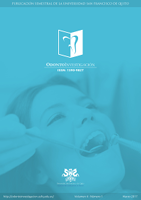Prevalence and distribution of bone defects in a group of potential untreated orthodontic patients using Cone Beam Computed Tomography.
Main Article Content
Abstract
Orthodontic diagnosis requires a thorough examination of the periodontal tissues; alterations such as dehiscences, fenestrations and other bone defects should be included within the diagnosis and the treatment plan.
The purpose of this study was to investigate the prevalence and distribution of bone defects in a group of potential orthodontic patients which were untreated, using Cone Beam Computed Tomography (CBCT), in order to evaluate their possible incorporation into basic diagnostic studies prior to orthodontic treatment.
The presence of dehiscences and fenestrations was analyzed in a total of 33 CBCTs and 792 teeth, and the thickness of the vestibular and palatal or lingual alveolar bone was measured in the middle third of 528 teeth. The data obtained were used to perform a descriptive and inferential statistical analysis that yielded the following results: 36% of the sample presented some type of bone defects; dehiscences were more common than fenestrations and were more common in the lower arch, while fenestrations were in the upper; the thicker cortical bone was found on the lingual surface of lower molars, and the thinner cortical bone on the buccal surface of lower canines.
As CBCTs have the potential to replace conventional radiographs and allow accurate diagnostic decisions based on each patient's bone architecture, I recommend their use as a diagnostic aid, especially in high-risk patients.

